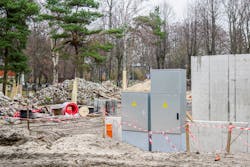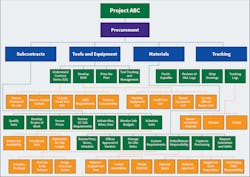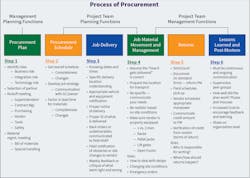The Pitfalls of Owner-Supplied Material
The name of the game in construction is increasing productivity and managing risk. Risk, specifically in construction, comes in many forms, and many stakeholders attempt to manage it.
A current perception in the construction industry is that owners/end-users are dissatisfied with time, cost, and quality on the job. Their diagnosis is that there is an inefficient and costly procurement chain. The proposed remedy is that owners/end-users can manage risk and improve time, cost, and quality on the job by directly purchasing material and removing the middlemen (e.g., the electrical contractor).
ELECTRI International commissioned research to be conducted by MCA, Inc., in 2004 and again in 2018 to shed light on the actual cost drivers of construction projects. MCA, Inc.’s research, titled “Procurement Chain Management in the Construction Industry,” concluded that the procurement chain is not the source of the problem — it’s insufficient system productivity. At this point, the goal of the research shifted to identifying various models of procurement and determining which model tackles the labor productivity issues and improves value transfer to the owner by addressing time, cost, and quality rather than focusing on material cost.
The research identified three models of procurement:
- Model 1: Subcontractor procures the material, adds profit to it, and carries the labor, warranty, timing, and correctness risk.
- Model 2: General contractor (GC)/owner procures the material, and the subcontractor includes a line item for added labor and other risks.
- Model 3: Subcontractor and GC/owner work together to reduce structural costs by collective reduction of the risk and collaborative approach for procurement and labor management.
MCA, Inc.’s, research identified three key areas that are impacted by members of the supply chain stepping outside of their core competencies and attempting to reduce costs in areas that do not directly add or transfer value to the final project. One study involved a 349-day project where luminaires and switchgear were purchased directly. The areas impacted were:
- Increased material handling time, effort, and cost up to 4.4%
- Time delays and increased project duration up to 19%
- Degraded quality, requiring rework and added expense up to 34%
There is more to this story, however. To fully understand the situation, it is important to know the types of risk as well as purchasing versus procurement.
Types of risk
The three types of risk are business, technical, and integration. When attempting to manage risk on a job, it is important to define the type of risk and what risk you are trying to manage.
1. Business risk ― The probability of a difference between the expected and actual financial outcomes of a project; all investment of capital and cash flow-related risk.
Examples of business risk, also known as monetary risk, are invoicing, timesheets, material purchases, subcontractor’s payments, bonding, insurance, change orders, cash management, project organization structure and personnel, and profitability.
2. Technical risk ― The probability of a physical failure of the built environment to function according to customer requirements or structural requirements; all risk associated with expertise and skill required in an endeavor. In construction, it is the expertise and risk required to design, manufacture, or construct, and is proportional to the effect of the failure mode on the consumer usage of the completed building or structure.
Examples of technical risk for an electrical contractor are the electrically specific risks managed with industry-standard procedures, processes, and tools. These include code, inspection, design (architectural, structural, and MEP systems), installation requirements, durability testing, QA/QC, contamination testing, electrician’s knowledge, as-builts, and submittals. The technical risks are not a contributing factor in the discussion of owners or GC’s purchasing material.
3. Integration risk ― The probability of failure at the interface of resources required to complete the project, including manpower, material, money, and information; the risk associated with bringing together all required resources necessary to provide the final product or service timely, cost-effectively, and with expected quality.
Examples of integration risk are broad and are the key items bringing and aligning all the pertinent elements needed to install the job, such as manpower, money, and material.
A whole is defined as a sum of its parts, and the total risk of a project or job is defined as the sum of the business, technical, and integration risk. Integration risk is by far the most complicated to manage and has the most impact on the job. MCA’s data shows that more than 40% of the cost of labor on a job is due to material handling. Thus, the research proposes horizontal integration where supply chain members collaborate to reduce non-value-added activities and work-in-process.
Purchasing vs. procurement
Each construction project has four phases: planning, procurement, installation, and closure. The word procurement is chosen specifically because purchasing and procurement are distinctively different.
Figure 1 demonstrates the segments and boundaries included in the broad term of procurement.
Purchase of the material includes the business risk of quotes, negotiations on price for the lowest cost for the specific material, and the order. Procurement expands to include the integration risk of managing the on-site planning, on-site release responsibility, and timing of delivery to reduce time lost for material movement. Again, integration risk is bringing and aligning all the pertinent elements needed to install the job, including manpower, money, and material.
Figure 2 shows that the process of procurement accounts for not only the business risk but also the technical and integration risk.
Referring back to MCA, Inc.’s, research into the three proposed models, Models 1 and 2 have the GC/owner and the subcontractor working independently on the project integration risks. While the material costs may be slightly reduced in Model 2, this does not positively help the perceived issues with the procurement chain because the integration risks are not reduced and may even be higher. The project installation can be delayed due to additional material movement if the delivery of material is not planned.
The best model to reduce cost on a construction project is Model 3. Using the process of procurement above, the two parties work together, acknowledging all of the integration risks on the project, such as coordination with other trades for design, layout, and physical workspace; integration of the deliveries; managing the job-site cleanliness and safety; etc. This is where the owner/end-user can be satisfied with the time, cost, and quality on the job, and value transfer to the project owner is greatest.
What we learned is that, ultimately, the most productive job is always the most profitable job, and the job with the best collaboration and planning utilizing the competencies and expertise of each stakeholder is always the most productive. When everyone makes a profit, it’s because the total project cost and the tolerated waste are minimized by all parties involved. To achieve this goal, each stakeholder should perform the duties they are uniquely most capable and equipped to perform while leaving other duties to those that are likewise most capable.
Jennifer Daneshgari is the vice president of financial services at MCA, Inc., in Grand Blanc, Mich. She can be reached at [email protected]. Phil Nimmo IV is the vice president of business development at MCA, Inc. He can be reached at [email protected].
About the Author
Phil Nimmo, MCA, Inc.
Phil Nimmo is vice president of business development at MCA, Inc. He can be reached at [email protected].
Jennifer Daneshgari
Jennifer Daneshgari is the vice president of financial services at MCA, Inc. She can be reached at [email protected].


